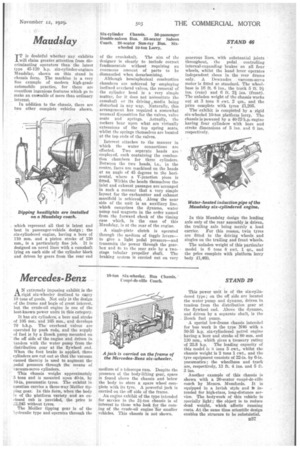Maudslay
Page 175

If you've noticed an error in this article please click here to report it so we can fix it.
TT is doubtful whether any exhibits
will claim greater attention from discriminating operators than the latest type 45-120 h.p. six-cylinder-enginen Maudslay, shown on this stand in chassis form. The machine is a very fine example of modern high-grade automobile practice, for there are countless ingenious features which go to make an ensemble of more than ordinary interest.
In addition to the chassis, there are two other, complete vehicles shown,
which represent all that is latest and best in passenger-vehicle design; the six-cylindered engine, having a bore of 110 mm. and a piston stroke of 130 mm., is a particularly fine job. It is designed on novel lines with a camshaft lying on each side of the cylinder block and driven by gears from the rear end of the crankshaft. The aim of the
-designer is clearly to include correct fundamentals without requiring an enortnous amount of parts to be dismantled when decarbonizing.
Although hemispherical combustion chambers are achieved by employing inclined overhead valves, the removal of the cylinder head is a very simple matter, for it does not neeessitate the camshaft or its driving, media being disturbed in any way. Naturally, this arrangement has required a somewhat unusual disposition for the valves, valve seats and springs. Actually, the rockers bear upon what are virtually extensions of the top spring seats, whilst the springs themselves are located at the top ends of the valves.
Interest attaches to the manner in which the water connections are effected. Two separate heads are employed, each containing the combustion chambers for three cylinders. Between the two heads, ix., in the centre, faces are machined on the heads at an eagle of 45 degrees to the horizontal, where a V-junction piece is fitted. Within the heads themselves the inlet and exhaust passages are arranged in such a manner that a very simple layout for the carburetter and exhaust manifold is achieved. Along the near side of the unit is an auxiliary line, which comprises the dynamo, water wimp and magneto in the order named from the forward cheek of the timing ease which, in the case of this Maudslay, is at the rear of the engine.
A single-plate dutch is operated through the medium of loggle levers— to give it light pedal pressure—and transmits the power through the gearbox and WI to the rear axle by a twostage tubular propeller shaft. The braking system is carried out on very
generous lines, with substantial joints throughout, the pedal controlling internal-expanding brakes on all four wheels, whilst the hand lever operates independent shoes in the rear drums only. A Dewaudre vacuum-servo motor is fitted as standard. The wheelbase is 16 ft. 6 ins., the track 5 ft. 91ins. (rear) and 6 ft. 2i ins. (front). The unladen weight of the chassis works Out at 3 tons 8 cwt. 2 qrs., and the Price complete with tyres 11,205.
The exhibit is completed by a rigid six-wheeled 10-ton platform lorry. The chassis is powered by a 40-75-h.p engine having four cylinders with bore and stroke dimensions of 5 ins. and 6 ins, respectively.
In this Maudslay design the leading axle only of the rear assembly is driven, the trailing axle being merely a load carrier. For this reason, twin tyres are fitted to the driving wheels and singles on the trailing and front wheels.
The unladen weight of this particular model is 6 tons 8 cwt. 1 qr., and the price complete with platform lorry body £1,460.








































































































































































































































































































































